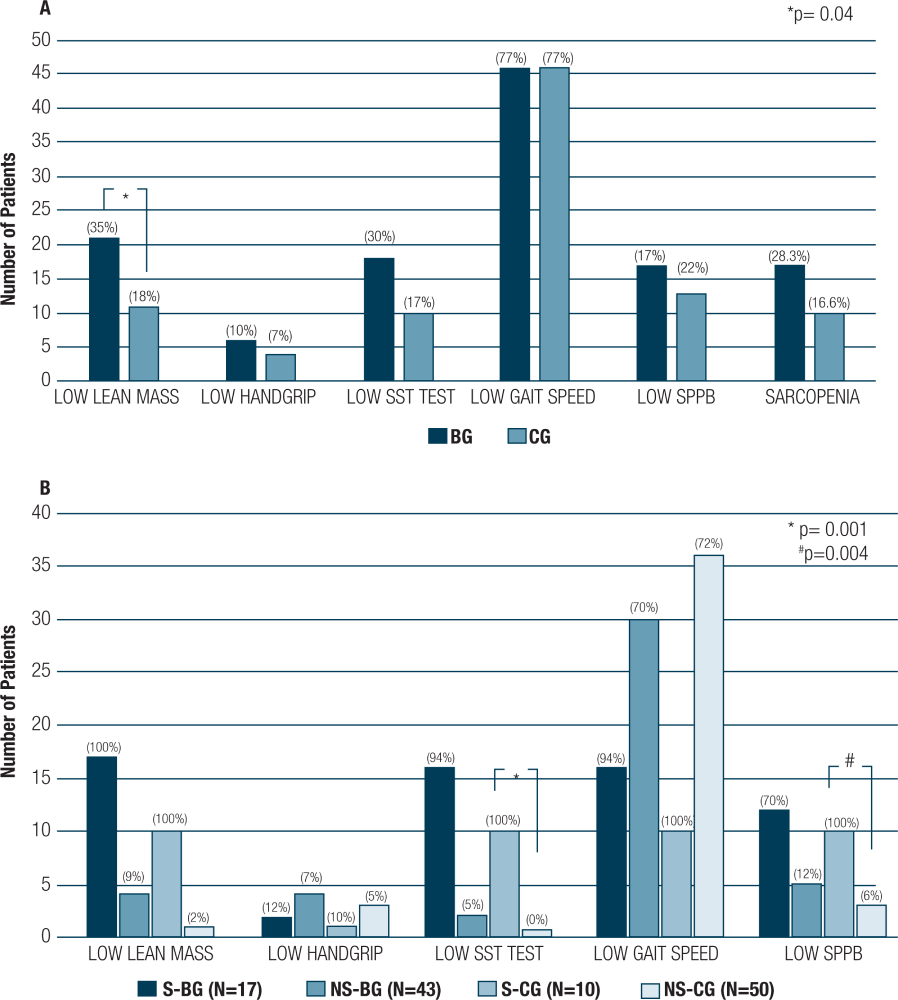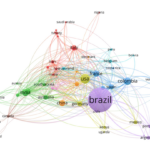Daniela Barros, post graduate student of the Surgical Clinic Program at Ribeirão Preto Medical School, University of São Paulo (FMRP-USP). Ribeirão Preto, SP, Brasil.
 In an observational, cross-sectional study (Prevalence of sarcopenia in women at stable weight phase after Roux-en-Y gastric bypass) conducted by Buzza et al. (BUZZA, A.F.B., et al.) from Universidade Federal do Paraná and Hospital Evangélico Mackenzie, Curitiba, (PR, Brazil), patients were invited to participate in the trial during their routine visit in the Outpatient Obesity Clinic of the research center, from March 2017 to May 2019.
In an observational, cross-sectional study (Prevalence of sarcopenia in women at stable weight phase after Roux-en-Y gastric bypass) conducted by Buzza et al. (BUZZA, A.F.B., et al.) from Universidade Federal do Paraná and Hospital Evangélico Mackenzie, Curitiba, (PR, Brazil), patients were invited to participate in the trial during their routine visit in the Outpatient Obesity Clinic of the research center, from March 2017 to May 2019.
Women (18-65 years old) who underwent bariatric surgery (BG) ≥ 2 years and reached stable weight ≥ 6 months, were investigated. Control group (CG) comprised non-operated matched women with obesity. Body composition was determined through dual-energy X-ray absorptiometry. Low lean mass (LLM) was defined as appendicular lean mass index (ALM kg/height m2) < 5.5 kg/m2. Physical strength was assessed through dynamometer and sit-to-stand test (SST), whereas performance was assessed through 4-m gait speed and Short Physical Performance Battery Tests (SPPB). Sarcopenia was diagnosed in the presence of LLM and low strength. (BUZZA, A.F.B., et al.)
All patients and controls completed questionnaires focused on collecting socio-demographic data, information about current or pre-surgical comorbidities (diabetes, hypertension, thyroid disorders, sleep apnea), time of and age at menopause, hormone replacement therapy, alcohol intake and smoking habit, physical activity frequency and duration on a weekly basis (self-reported), medications and supplements in use, time of and age at surgery (BUZZA, A.F.B., et al.).
One-hundred and twenty women (60 in each group, 50 ± 9.7 years old) were investigated. All anthropometric and body composition parameters were lower in BG than in CG, whereas strength and performance were similar between groups. Women with reduced strength presented high total fat mass and low physical activity level (p < 0.005). LLM was observed in 35% of BG and in 18.3% of CG (p = 0.04), whereas sarcopenia was diagnosed in 28.3% of BG and in 16.6% of CG (p = 0.12). Sarcopenic women in BG had better performance both in SST (p = 0.001) and SPPB (p = 0.004). Total lean mass (OR:1.41, 95% CI [1.18; 1.69], p < 0.001) and obesity (OR: 38.2 [2.27; 644.12], p < 0.001) were associated with sarcopenia in the multivariate analysis (BUZZA, A.F.B., et al.).
Overall, individuals with obesity have greater muscle mass and strength than individuals without obesity, since weight load and gravity act as stimuli to increase muscle formation (TOMLINSON, D.J., et al.; TALLIS, J., et al.). Nevertheless, weight loss is associated with lean mass reduction; thus, when people with obesity reach normal weight, this process may lead to decreased muscle strength (TALLIS, J., et al.).
Sarcopenia lies on low lean mass associated with decreased strength and/or functional capacity (BORBA, V.Z.C., et al.), which can significantly increase morbidity and mortality in comparison to LLM alone (LI, G.H., et al.). Whenever sarcopenia is associated with obesity, it is called sarcopenic obesity. Sarcopenic obesity is featured by anomalous body composition, with higher fat mass proportion associated with sarcopenia (ZAMBONI, M., et al. DONINI, L.M., et al.), which leads to reduced physical activity and acts as vicious cycle to maintain this condition (PELLEGRINELLI, V. et al.).
Prospective, cohort study conducted with 184 patients with obesity (79% women, mean age 42 years) subjected to pre-bariatric assessment has shown that fifteen (8%) women met the diagnostic criteria of sarcopenia (VOICAN, C.S., et al.). Bariatric surgery almost invariably predisposes patients to experience sarcopenic obesity onset, at least at the early rapid weight loss phase, due to significantly negative energy balance associated with this procedure (BARAZZONI, R., et al).
However, data on sarcopenia prevalence in the long-term after bariatric surgery, when patients reach stable weight, remain scarce and sparse in the literature. Thus, the aim of the current study was to investigate sarcopenia incidence during the post-bariatric surgery at stable-weight period in a group of women subjected to Roux-en-Y gastric bypass (RYGB), whose findings were compared to those of the control group, which comprised non-operated matched women with obesity. (BUZZA, A.F.B., et al.).
In this context, the study has shown sarcopenia diagnosis in 28% of women subjected to RYGB surgery, at least 2 years after they reached stable weight. This prevalence was not significantly different from that (nearly 17%) observed in the control group, which comprised non-operated women with obesity, despite the striking differences in body composition between groups, such as significant difference in LLM prevalence, which is one of sarcopenia’s components. In addition, sarcopenic women in both investigated groups presented similar total lean mass in grams (TLM), although sarcopenic patients in BG have shown better strength and performance parameters (SST and SPPB scores) (BUZZA, A.F.B., et al.).
The literature has few studies focused on investigating sarcopenia in post-bariatric patients. The correct identification of sarcopenia in bariatric patients is an important factor to help assessing muscle quantity and quality, since muscle strength is one of the best predictors of health and mortality outcomes, regardless of muscle mass (CRUZ-JENTOFT, A.J, et al.).
The cross-sectional nature of the current study was one of its main limitations, due to lack of pre-surgical assessment of patients’ body composition, physical strength, and performance to enable evaluating and comparing BG’s results (BUZZA, A.F.B., et al.).
In conclusion, women subjected to RYGB did not show increased sarcopenia prevalence in comparison to non-operated women with obesity, despite the significant weight loss, higher LLM frequency and striking differences in body composition. Women in BG have shown better physical performance among those diagnosed with sarcopenia (BUZZA, A.F.B., et al.).
Referências
TOMLINSON, D.J., et al. The impact of obesity on skeletal muscle strength and structure through adolescence to old age. Biogerontology. 2016, vol. 17, nº 3, pp. 467-83. [viewed 11 Aug 2022]. https://doi.org/10.1007/s10522-015-9626-4. Available from: https://www.ncbi.nlm.nih.gov/pmc/articles/PMC4889641/
TALLIS, J., et al. The effects of obesity on skeletal muscle contractile function. J Exp Biol. 2018, vol. 221, nº Pt 13, pp. jeb163840. [viewed 11 Aug 2022]. https://doi.org/10.1242/jeb.163840. Available from: https://journals.biologists.com/jeb/article/221/13/jeb163840/33759/The-effects-of-obesity-on-skeletal-muscle
BORBA, V.Z.C., et al. Mechanisms of Endocrine Disease: Sarcopenia in endocrine and non-endocrine disorders. Eur J Endocrinol. 2019, vol. 180, nº 5, pp. R185-99. [viewed 11 Aug 2022]. https://doi.org/10.1530/EJE-18-0937. Available from: https://eje.bioscientifica.com/view/journals/eje/180/5/EJE-18-0937.xml
LI, G.H., et al. The effect of different measurement modalities in the association of lean mass with mortality: A systematic review and meta-analysis. Osteoporos Sarcopenia. 2021, vol. 7, nº Suppl 1, pp. S13-8. [viewed 11 Aug 2022]. https://doi.org/10.1016/j.afos.2021.02.004. Available from: https://www.ncbi.nlm.nih.gov/pmc/articles/PMC8088995/
ZAMBONI, M., et al. Sarcopenia and obesity. Curr Opin Clin Nutr Metab Care. 2019, vol. 22, nº 1, pp. 13-9. [viewed 11 Aug 2022]. https://doi.org/10.1097/MCO.0000000000000519. Available from: https://journals.lww.com/co-clinicalnutrition/Abstract/2019/01000/Sarcopenia_and_obesity.4.aspx
DONINI, L.M., et al. Critical appraisal of definitions and diagnostic criteria for sarcopenic obesity based on a systematic review. Clin Nutr. 2020, vol. 39, nº 8, pp. 2368-88. [viewed 11 Aug 2022]. https://doi.org/10.1016/j.clnu.2019.11.024. Available from: https://www.clinicalnutritionjournal.com/article/S0261-5614(19)33151-6/fulltext
PELLEGRINELLI, V. et al. Human Adipocytes Induce Inflammation and Atrophy in Muscle Cells During Obesity. Diabetes. 2015, vol. 64, nº 9, pp. 3121-34. [viewed 11 Aug 2022]. https://doi.org/10.2337/db14-0796. Available from: https://diabetesjournals.org/diabetes/article/64/9/3121/34825/Human-Adipocytes-Induce-Inflammation-and-Atrophy
VOICAN, C.S., et al. Predictive score of sarcopenia occurrence one year after bariatric surgery in severely obese patients. PLoS One. 2018, vol. 13, nº 5, pp. e0197248. [viewed 11 Aug 2022]. https://doi.org/10.1371/journal.pone.0197248. Available from: https://www.ncbi.nlm.nih.gov/pmc/articles/PMC5951560/
BARAZZONI, R., et al. Sarcopenic Obesity: Time to Meet the Challenge. Obes Facts. 2018, vol. 11, nº 4, pp. 294-305. [viewed 11 Aug 2022]. https://doi.org/10.1159/000490361. Available from: https://www.ncbi.nlm.nih.gov/pmc/articles/PMC6189532/
CRUZ-JENTOFT, A.J, et al. Sarcopenia: revised European consensus on definition and diagnosis. Age Ageing. 2019, vol. 48, nº 1, pp. 16-31. [viewed 11 Aug 2022]. https://doi.org/10.1093/ageing/afy169. Available from: https://www.ncbi.nlm.nih.gov/pmc/articles/PMC6322506/
Para ler o artigo, acesse
BUZZA, A.F.B., et al. Prevalence of sarcopenia in women at stable weight phase after Roux-en-Y gastric bypass. Arch Endocrinol Metab. 2022, vol. 66, nº3, pp. 362 – 371. [viewed 11 Aug 2022]. https://doi.org/10.20945/2359-3997000000494. Available from: https://www.scielo.br/j/aem/a/QgmFFVTKpDF8wRwGFj8Zz3R/?lang=en
Links externos
Andreia Fabiana Bueno Buzza: https://orcid.org/0000-0003-1266-7868
Archives of Endocrinology and Metabolism – AEM: https://www.scielo.br/aem
Como citar este post [ISO 690/2010]:



















Recent Comments